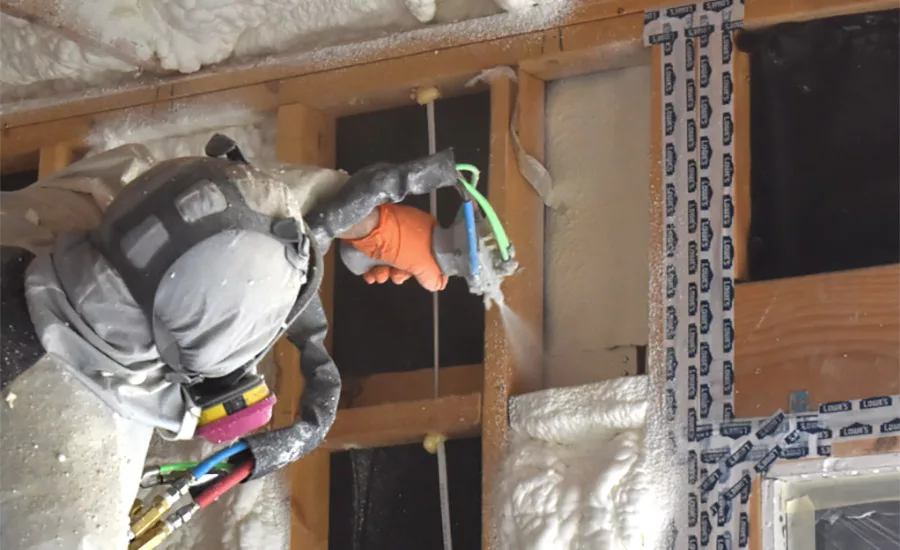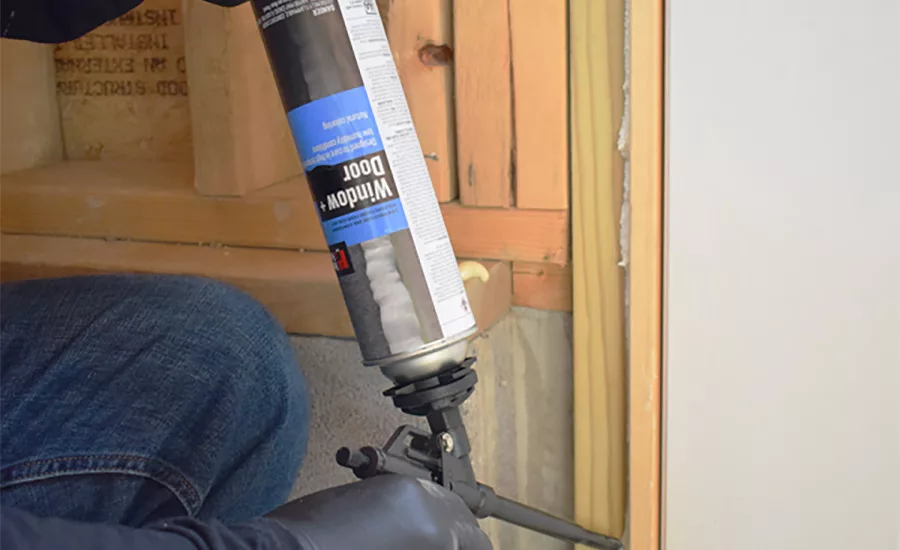Why Effective Deployment of Spray Foam Insulation Requires Attention and Education

Image courtesy of ICP Building Solutions Group.

Image courtesy of ICP Building Solutions Group.
Today’s building owners and operators are continuously looking for new ways to enhance their facility’s efficiency. There are plenty of ways to accomplish this goal, but one of the simplest and most effective is the strategic deployment of spray polyurethane foam for insulation and sealing purposes.
For adhesives and sealants industry professionals and advocates, it’s worth understanding the benefits that can be had with successful installations. Installed properly and with the appropriate product selections, spray polyurethane foam can contribute to a more efficient, healthier building envelope. In this article, we’ll explore the particulars of different low-pressure spray foam insulation and sealant products and their intended applications, the benefits that can be had from their installation, and how to identify the right areas to apply them.
Distinguishing Among Spray Foam Products
Before deploying spray polyurethane foam for any building enhancement project, it’s critical for professionals to be informed about the types of foam technologies that can and should be used depending upon the application.
Within the low-pressure polyurethane foam category, there are three subcategories of foam based on application method:
- Low-pressure spray polyurethane foam insulation. These products are chemically cured, two-component systems designed to fill and insulate large voids and surfaces. This delivers excellent adhesion properties and creates a continuous air barrier completing the building envelope, which results in improved indoor air quality and lower energy costs.
- Low-pressure one-component polyurethane foam sealants and adhesives. These products are pre-reacted in the can and undergo further reaction with ambient moisture at the time of application. One-component polyurethane foam sealants and adhesives are generally used for smaller-bead applications.
- Low-pressure pour-in-place polyurethane foam. These products are chemically cured, two-component systems specifically designed for filling cavities, molds, fixtures, or holes where a slower curing and expanding polyurethane foam is required.
In any case, it's important to be certain that your selection meets the criteria for its intended application. And it’s here where professionals must exercise care. For example, it is not uncommon to encounter spray foam products that are advertised for use as a sealant, as insulation, or both. In such cases, it's important to verify that the product does indeed maintain the appropriate approvals for its intended use.
Consider that a sealant is intended to eliminate gaps around fenestrations, framing gaps, and planar junctions like roof and wall intersections, as per ASTM C1620. These products primarily serve as a barrier to prevent air movement around construction assemblies. Comparatively, per ICC 1100, an insulation product is used in large cavities, open areas, and between framing to reduce heat transfer through construction assemblies.
Sealants and insulation must meet respective codes, testing requirements, and specifications including U.S. building codes, FTC labeling or testing requirements, OSHA regulations for hazard reporting, and PUR product standards. Safe, credible, and reliable products should come with documentation and testing data. Here are some items you can look for to verify your selection:
Safety Data Sheet (SDS). All potentially hazardous materials require an SDS, which includes specific requirements including safe handling and disposal. SDSs should be readily available from the manufacturer.
- Technical Data Sheet (TDS). The TDS states all relevant testing, approvals, and installation considerations specific to the product and should be readily available from the manufacturer.
- Test Methods Used. Products sold for use in the United States must be tested in accordance with U.S. test methods. Many imported products use European (DIN) test methods, which are not equivalent and not accepted by U.S. agencies.
- Third-Party Verification of Building Code Compliance. Insulation and sealant manufacturers often include references to product evaluations conducted by recognized independent third-party agencies on the product’s TDS.
- Labeling Compliance. The Federal Trade Commission, Bureau of Home Furnishings (California), and the Department of Transportation all have specific labeling requirements for insulation and sealants used in the United States.
- Product Use Statements. The confusion, risk, and liability arise when offshore-manufactured sealants are promoted, sold, and used as insulation while only meeting the sealant standard, and in some cases not even meeting the U.S. sealant standard.
Benefits for Building Envelopes
So, why can spray polyurethane foam contribute to significant value to buildings everywhere?
Compared to other insulation types like fiberglass or cellulose, spray polyurethane foam maintains one of the highest R-values per inch. This allows it to provide industry-leading thermal resistance, thus reducing heat loss and minimizing energy costs for heating and cooling, helping to enhance the overall efficiency of any building.
Spray foam insulation also works as an air and moisture barrier in the right applications. Foam expands to fill gaps and cracks, effectively sealing air leaks, reducing drafts, and improving indoor air quality. Further, as a moisture barrier, spray foam can help prevent mold and mildew growth when installed properly, which is crucial for maintaining a safe and healthy environment.
Spray foam insulation adheres to surfaces and hardens, adding rigidity to walls and roofs, which can improve the building’s structural integrity. The dense composition of spray foam insulation also helps to absorb sound, reducing noise pollution from outside or between different areas within the building. This can be ideal for office buildings, apartments, and mixed-use properties where soundproofing is important.
Applied properly, spray foam will provide long-term benefits as well. It is highly durable and does not sag, shrink, or deteriorate over time, thus requiring minimal maintenance over the course of its life.
Key Applications for Spray Foam
Spray foams and sealants can be applied throughout the building envelope, including throughout walls, roofs and attic spaces, basements and crawl spaces, and windows and doors. Gaps around windows, doors, and other openings can also be targeted with foam sealants to further prevent drafts and leaks.
While visual inspection can help determine areas where spray foam will be effective, more advanced diagnostic methods can be applied by trained professionals that can more comprehensively determine air leak rates and problem areas throughout the entire building envelope. For example: A blower door test is a common method to measure air exchanges per hour and identify common leak points. The test uses a powerful fan that is temporarily mounted into the frame of an exterior doorway. After calibrating the device, the fan pulls air out of the building, lowering the air pressure inside. The higher outside air pressure then flows in through all unsealed openings such as gaps, cracks, or wiring penetrations.
Infrared cameras can also be used to inspect walls, ceilings, and floors to find specific locations where insulation is missing, and air is leaking. Elsewhere, a nontoxic smoke pencil test can also be used to detect air leaks. These tests determine the air infiltration rate of the facility as well as the specific points that will most benefit from spray foam.
Spray polyurethane foam sealants and insulation solutions are some of the most effective means our industry has to offer to help strengthen and fortify building envelopes of all kinds, from residential homes to commercial spaces. It’s why continued advocacy for certified and tested products, deployed strategically in effective applications, is important.
To learn more about spray foam insulation and how to seize the benefits, visit www.HandiFoam.com.
Image courtesy of ICP Building Solutions Group.
Looking for a reprint of this article?
From high-res PDFs to custom plaques, order your copy today!




